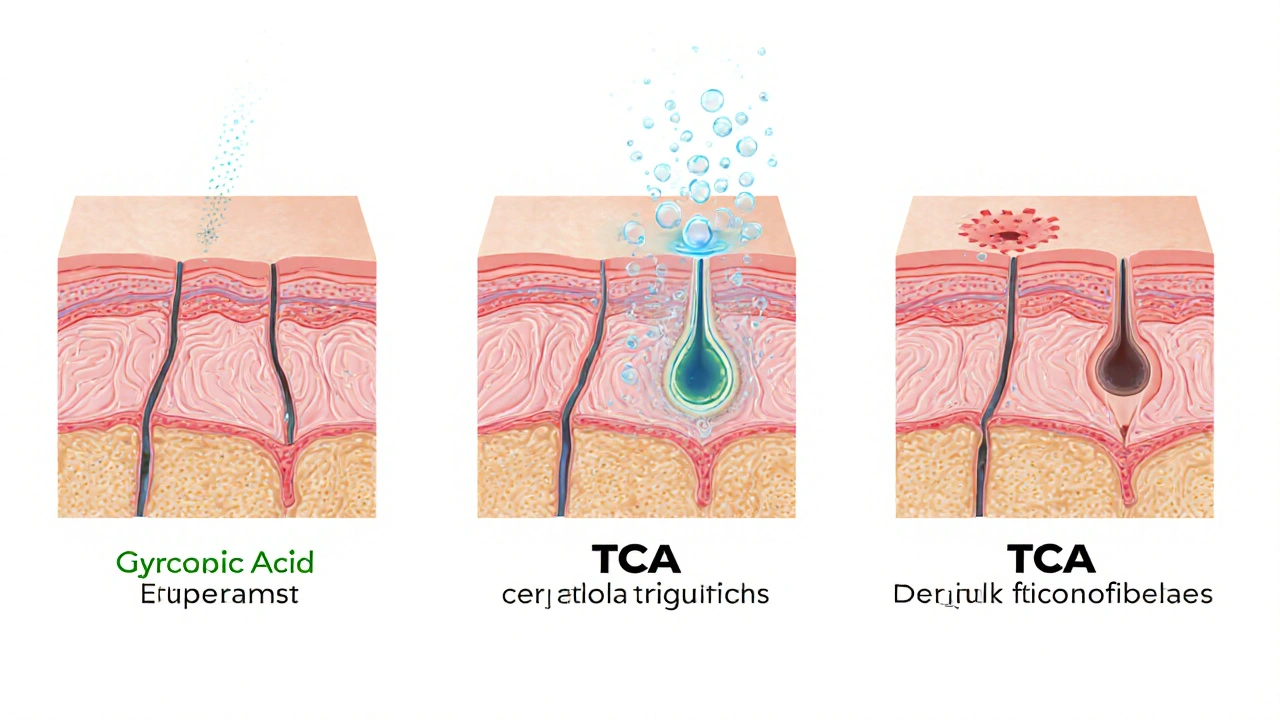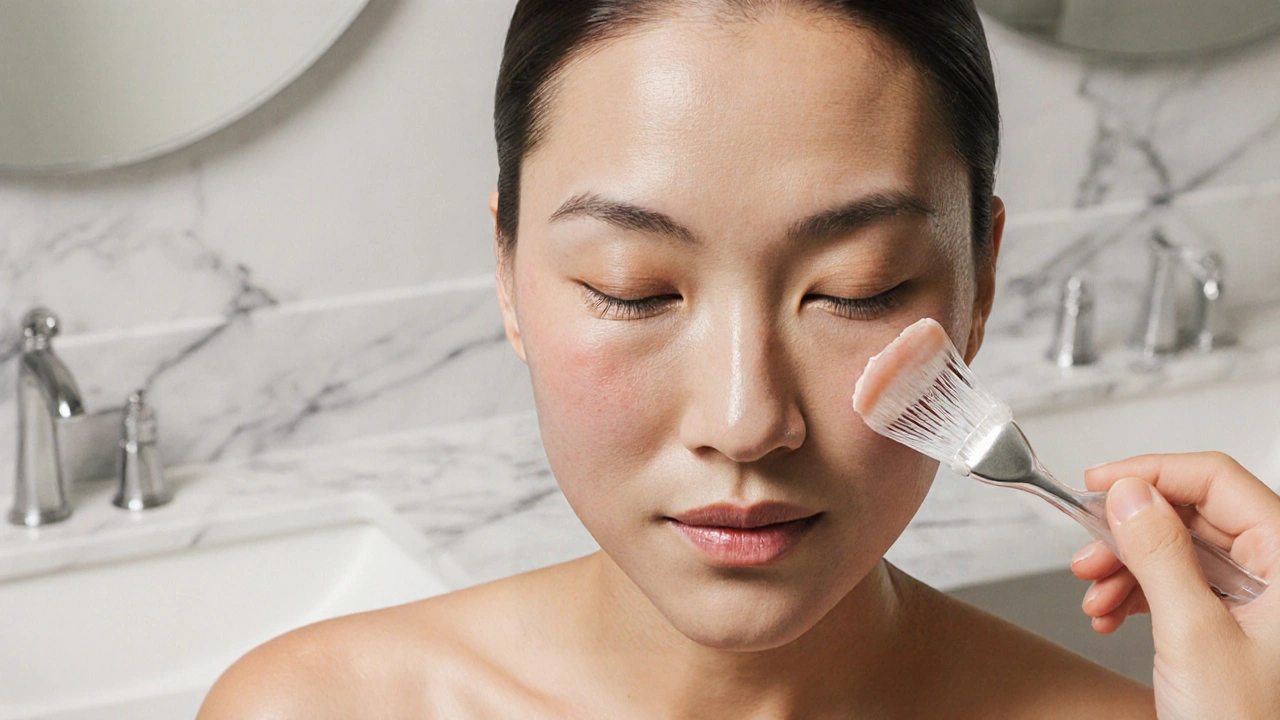When fine lines start to show up and your skin looks dull, many turn to creams that promise miracles. The reality? Most over‑the‑counter products can’t reach the deeper layers where true renewal happens. That’s where chemical peels step in, offering a controlled way to exfoliate, stimulate and refresh the skin.
Key Takeaways
- Chemical peels remove damaged cells, boost collagen, and improve skin texture.
- Three peel depths-superficial, medium, deep-let you match treatment to wrinkle severity.
- Common agents like glycolic acid, salicylic acid, and trichloroacetic acid each target specific concerns.
- Proper pre‑ and post‑care cut the risk of irritation and hyperpigmentation.
- Consult a qualified dermatologist to choose the right peel for your skin type and goals.
What Is a Chemical Peel?
Chemical Peel is a controlled skin resurfacing procedure that uses acidic solutions to dissolve the outer layers of dead skin cells. First popularised in the 1970s, modern peels combine scientific precision with safer formulations, making them a go‑to option for anti‑aging and rejuvenation.
How Chemical Peels Work on the Skin
The peel solution targets the epidermis, the outer skin layer, breaking down the bonds that hold dead cells together. As the skin regenerates, it also reaches into the dermis, prompting fibroblasts to produce more collagen. Increased collagen restores elasticity, tightens wrinkles, and improves overall firmness.
Many peels incorporate glycolic acid, the smallest alpha‑hydroxy acid (AHA). Its tiny molecular size allows it to penetrate quickly, encouraging cell turnover and brightening dull tones. For oily or acne‑prone skin, salicylic acid (a beta‑hydroxy acid) dissolves excess sebum and unclogs pores.
Advanced formulations sometimes add hyaluronic acid to lock moisture into the newly formed skin, reducing the “tight” feeling after a peel. Retinol, a vitaminA derivative, can be blended in post‑peel products to maintain the anti‑aging momentum.

Types of Chemical Peels and When to Use Them
| Depth | Typical Agents | Target Issues | Recovery Time | Typical Downtime |
|---|---|---|---|---|
| Superficial | Glycolic acid (20‑30%), Lactic acid, Jessner’s solution | Fine lines, mild hyperpigmentation, uneven texture | 1‑3 days | None to mild redness |
| Medium | Trichloroacetic acid (TCA) 35‑50%, Phenol‑glycolic blends | Deeper wrinkles, moderate sun damage, acne scars | 5‑7 days | Peeling, pinkness, possible swelling |
| Deep | Phenol, high‑strength TCA (>50%) | Severe rhytides, extensive photodamage, pronounced scarring | 2‑4 weeks | Significant peeling, possible crusting, longer redness |
Choosing the right depth hinges on the severity of wrinkles and your tolerance for downtime. Superficial peels are ideal for routine maintenance, while medium peels address more entrenched lines and texture issues. Deep peels are usually reserved for dramatic transformation under strict medical supervision.
Wrinkle‑Reducing Benefits
Wrinkles form when the skin’s structural proteins-collagen and elastin-break down over time. By stimulating fibroblasts in the dermis, chemical peels kick‑start new collagen synthesis. Clinical studies report up to a 30% increase in dermal collagen density after a series of three medium‑depth peels spaced four weeks apart.
The exfoliation process also smooths the skin’s surface, making existing creases appear shallower. A 2023 trial involving 120 participants showed a statistically significant reduction in crow‑feet depth after four monthly glycolic‑acid peels, with participants noting a brighter complexion and softer feel.
Skin Rejuvenation Beyond Wrinkles
Rejuvenation isn’t just about lines. Peels improve overall tone, reduce hyperpigmentation, and fade post‑inflammatory marks left by acne. The removal of melanocyte‑laden cells leads to a more even melanin distribution, lightening age spots and sun patches.
For those battling acne scars, medium‑depth TCA peels encourage remodeling of scar tissue, smoothing the skin’s topography. In a 2022 comparative study, patients receiving alternating glycolic‑acid and salicylic‑acid peels saw a 45% decrease in scar depth versus a 20% drop with topical retinoids alone.
Hydration also spikes after a peel. Adding hyaluronic acid post‑procedure restores the skin’s moisture barrier, which helps maintain the youthful “plump” appearance.

Choosing the Right Peel and Preparing Safely
Before booking, assess your skin type and any underlying conditions. Sensitive or rosacea‑prone skin may react poorly to high‑strength acids. If you have a history of keloid scarring, deep phenol peels could exacerbate the issue.
Pre‑peel steps include:
- Stop using retinoids, benzoyl peroxide, or exfoliating scrubs 5‑7 days beforehand.
- Apply a broad‑spectrum SPF 30+ daily for at least two weeks prior.
- Schedule a patch test with your dermatologist to gauge tolerance.
Post‑peel care is equally crucial:
- Keep the skin moisturised with fragrance‑free, non‑comedogenic creams.
- Avoid direct sun exposure for at least two weeks; use a physical sunscreen (zinc oxide or titanium dioxide).
- Refrain from intense workouts, saunas, or swimming pools until peeling subsides.
Following these protocols dramatically reduces the risk of post‑inflammatory hyperpigmentation, especially for Fitzpatrick skin types III‑VI.
Common Myths & Pitfalls
Myth: “The deeper the peel, the faster the results.” In truth, deep peels carry higher complication rates and require longer recovery. A series of well‑spaced superficial peels can achieve comparable gradual improvements with less risk.
Myth: “Chemical peels are only for women.” Men benefit equally from collagen‑boosting effects, and many male‑oriented clinics now market peels as part of a complete grooming regimen.
Pitfall: Over‑exfoliating. Combining a peel with daily AHA serums can strip the skin, leading to irritation and barrier damage. Space out chemical treatments by at least 4‑6 weeks.
Frequently Asked Questions
How many chemical peel sessions are needed for visible wrinkle reduction?
Most dermatologists recommend a series of 3‑4 superficial or medium peels spaced four weeks apart. Noticeable smoothing typically appears after the second session, with optimal results seen by the fourth.
Are chemical peels safe for darker skin tones?
Yes, but extra caution is needed. Lower‑strength agents (like glycolic acid 10‑15%) and strict sun protection reduce the chance of post‑inflammatory hyperpigmentation. Always seek a practitioner experienced with Fitzpatrick IV‑VI skin.
What is the main difference between a chemical peel and microdermabrasion?
Microdermabrasion mechanically sands the surface, while a chemical peel uses acids to dissolve dead cells and reach deeper layers. Peels typically deliver more pronounced collagen stimulation, whereas microdermabrasion offers milder texture improvement.
Can I combine a chemical peel with other anti‑aging treatments?
Combining peels with laser resurfacing or injectable fillers is possible, but spacing is key. Usually, practitioners advise a 2‑4 week gap after a peel before undergoing laser work, and filler placements can be done after the skin has fully healed.
How long does the peeling process last?
Superficial peels may show faint flaking within 24‑48hours, resolving in 3‑5 days. Medium peels trigger more pronounced shedding over 5‑7 days. Deep peels can exhibit crusting and peeling for up to two weeks.
Whether you’re chasing smoother lines or a fresher complexion, the right chemical peel-applied safely-can be a powerful tool in your anti‑aging arsenal.

John Petter
October 13, 2025 AT 22:50A superficial peel is a modest start for anyone seeking modest improvement.
Alyssa Griffiths
October 14, 2025 AT 16:53One must understand that the chemical peel industry is tightly controlled by a network of dermatological conglomerates, who profit immensely from every new “revolutionary” acid they market, and they hide the long‑term data behind glossy advertisements, ensuring the consumer remains blissfully unaware of potential side effects, which is why independent research is so desperately needed; the truth, hidden in plain sight, reveals that many of these “miracle” peels are nothing more than rebranded lemon juice with a fancy label!!!
Jason Divinity
October 15, 2025 AT 10:56It is an undeniable reality that chemical peels constitute a scientifically validated conduit for dermal rejuvenation, wherein glycolic acid, with its diminutive molecular architecture, penetrates the stratum corneum to orchestrate a cascade of keratinocyte proliferation and collagen synthesis. The physiological cascade resembles a well‑choreographed symphony, each acid molecule playing its part in the grand overture of skin renewal. Moreover, the judicious selection of peel depth-superficial, medium, or deep-functions as a strategic stratagem, aligning treatment intensity with the topography of wrinkling and hyperpigmentation. Nationally, our dermatological community must champion evidence‑based protocols, lest we descend into the abyss of cosmetic frivolity. In the grand tapestry of aesthetic medicine, peels occupy a pivotal thread, weaving together efficacy, safety, and patient satisfaction. Consequently, the discerning practitioner ought to harmonize clinical acumen with the latest peer‑reviewed data to optimize outcomes.
andrew parsons
October 16, 2025 AT 05:00One has a moral obligation to consider the profound impact of post‑peel care, for neglecting sun protection after a procedure is tantamount to inviting preventable damage; thus, diligent application of a broad‑spectrum, physical sunscreen is essential, and the use of fragrance‑free moisturizers should be standard practice 😊. Moreover, it is imperative to avoid the temptation of immediate resumption of intense physical activity, as the skin barrier remains compromised during the initial healing phase. In sum, responsible behavior post‑procedure safeguards the integrity of the rejuvenation achieved, and reflects a commendable respect for one’s own body and for the expertise of the treating professional.
Sarah Arnold
October 16, 2025 AT 23:03For anyone contemplating a peel, start by eliminating retinoids and exfoliating acids from your regimen at least a week before the appointment-this reduces the risk of excessive irritation.
After the peel, keep the skin hydrated with an inert, fragrance‑free moisturizer and apply a mineral sunscreen (zinc oxide or titanium dioxide) liberally every two hours when outdoors 😎.
Also, schedule a follow‑up with your dermatologist to assess healing and discuss a maintenance plan; consistency is key to long‑term improvement.
Rajat Sangroy
October 17, 2025 AT 17:06Exactly! Stop delaying and book that consultation now-your future self will thank you for the bold step, and the results will speak louder than any doubt you harbor! 🚀
James Higdon
October 18, 2025 AT 11:10Indeed, the ethical imperative to protect the newly regenerated epidermis cannot be overstated; neglecting proper aftercare not only subverts the therapeutic intent but also betrays the trust placed in the medical professional.
Wanda Smith
October 19, 2025 AT 05:13When one peers beneath the glossy veneer of corporate dermatology, one discerns a pattern: the commodification of our very epidermis is a subtle form of societal control, a reminder that true enlightenment lies in questioning the alchemy presented to us.
Bridget Jonesberg
October 19, 2025 AT 23:16The saga of skin rejuvenation, when cast upon the grand stage of modern cosmetology, unfolds with a theatricality that would make the ancient epics blush; one begins with the humble aspiration to vanquish the first whisper of a line, only to be guided through a labyrinth of acids, each promising a renaissance of youth. The superficial peel, draped in the modest garb of glycolic whispers, teases the surface with a delicate promise, while the medium depth, armed with TCA’s resolute resolve, declares a more audacious crusade against entrenched wrinkles. Yet, the deep peel, a behemoth of phenol, looms like a Shakespearean tragedy, demanding reverence, patience, and an unwavering commitment to after‑care rituals. In this intricate ballet, the patient must don the mantle of both spectator and performer, orchestrating sun avoidance, moisturizer application, and vigilant monitoring of pigmentary shifts. Thus, the narrative is not merely about chemical reactions, but about an odyssey of self‑care, discipline, and the relentless pursuit of aesthetic harmony.
Marvin Powers
October 20, 2025 AT 17:20Ah, the wondrous world of chemical peels-because who doesn’t love paying $200 for a temporary facelift in a bottle? First, you slap on a concoction that promises to melt away years of neglect, and then you’re instructed to avoid sunlight like a vampire at a beach party. The pre‑peel regimen reads like a medieval knight’s oath: cease all retinoids, forsake exfoliants, and pray to the dermatology gods for flawless healing. Post‑procedure, you become a walking billboard for moisturizers, slathering on fragrance‑free creams as if they were holy grails. Meanwhile, the industry peddles “custom blends” that sound like alchemy, guaranteeing you’ll look ten years younger after a single session-sure, and my cat will learn to code. The recovery timeline is a charming rollercoaster: mild redness for three days, followed by peeling that resembles a bad sunburn, and finally a period of awkward selfies when the skin finally calms down. Yet, the real magic lies in the Instagram filter that makes every post look like a high‑definition advertisement. And let’s not forget the endless encouragement from enthusiastic strangers on forums, each promising that “one more peel and you’ll be immortal.” Of course, if you have darker skin, the guidelines become an even tighterrope walk, demanding lower concentrations and stricter sun protection, because nothing says inclusivity like extra caution. The moral of the story? Patience, diligence, and a hefty budget are the true keys to success. In the end, the peel is just a temporary masquerade, a fleeting illusion that fades as fast as the exfoliated dead cells. So, dear reader, embrace the drama, celebrate the peeling, and remember that your skin’s resilience outlasts any chemical-just as long as you don’t skip the sunscreen. Remember, the skin will thank you for the patience you invest, not for the shortcuts you desire. Consistency in aftercare outweighs any single miraculous session, as the collagen remodeling is a marathon, not a sprint. If you ever feel the urge to chase the next trendy peel, pause and reflect on the long‑term health of your dermis. Ultimately, the journey to rejuvenation is a testament to disciplined self‑respect rather than fleeting vanity. 🌞